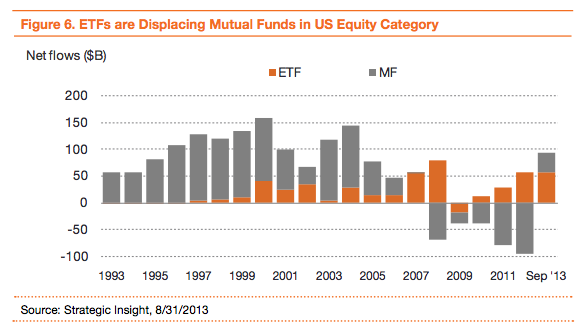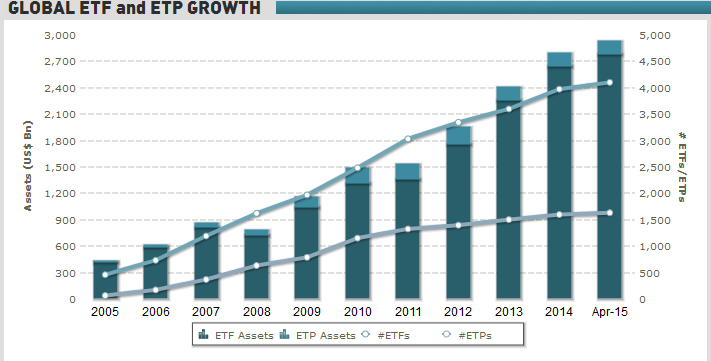ETFs are transforming. According to PWC (2013) exchange traded funds have benefitted over 20 years from massive growth due to their fine advantages for investors. By August (2013) it is reported that global ETF assets stood at $2.2 trillion in assets. This two part series will look at how the ETF industry has been changing and what this means for investors. As PWC explains:
“Evolving and proliferating as the attracted new users, ETFs went from a single vehicle providing exposure to large cap US equities to thousands of products representing a dizzying range of asset classes and strategies.”
What is ETF?
Understanding this change is helpful for investors, but before progressing further, it is helpful to understand what an ETF is. Mitch Tuchman (2013) writing for Forbes does a good job of explaining this. He explains that an ETF is a type of an index fund because it has the same goal. The goal of the ETF is:
“To provide investors with a benchmark return at minimal cost.”
There is one very important difference between ETFs and index funds. Index funds are expensive to trade, but ETFs have the advantage of being traded commission free in many cases. It is explained that not all ETFs work in the way that they copy index funds, so some caution needs to be taken during the selection process. It is argued that the flexibility of an ETF with its low trading cost, along with the performance of an index fund is likely to be best achieved by utilising the biggest and best known ETFs on the market. These are the ones that have proven ability to meet widely understood benchmarks and which have a good track record showing that they can achieve their goals.
Source: The next generation of ETFs, PWC
ETF as a disruptor
As PWC points out, ETFs have been an important disruptor and it is estimated that they are going to continue to grow at tremendous rates. They have been popular because they are low cost, offer tax efficiency, liquidity, transparency and intra-day pricing. As of August 2013, it is reported that there were 5,000 ETFs and exchange traded products (ETPs) worldwide. This has been threefold increase since the financial crisis. The USA is the biggest market for ETFs, and 70% of global ETF assets are found there. Europe comprises the second biggest market, but has only a quarter of the assets found in the USA are found there. Meanwhile, ETFs are growing extremely rapidly in Asia.
One of the most important trends in this area has been the advent of actively managed funds. There have been a number of barriers to this development, but actively managed ETFs account for $13.8 billion in the USA alone. ETFs are not only launching at a very fast rate, but are also closing down very quickly. There were 117 ETF fund closures in the six months to the middle of 2013. It is argued that ETFs are moving from a situation of security selection to asset selection, and this change is especially noticeable in large, liquid markets. Indeed, ETFs in the USA have had a big effect on displacing mutual funds. Popularity has been driven by the ability to produce specific exposure.
Source: ETFs: $3 Trillion is Nice, but $6 Trillion is Better
In the past institutional investors showed a lot of interest in ETFs, but this has been changing to some degree, in regard to how these are seen and used. The reason for institutional investors using ETFs at the outset was for transition management, but at the current time these are viewed as long term holdings, as core allocation vehicles. By 2012, nearly 3,400 institutional investors spread across 50 different countries held ETFs or ETPs, which is double the number that used ETFs seven years ago. In addition to this, 90% of institutional investors are planning to at least maintain, if not increase their level of ETF investments in 2013. Investment advisors and hedge funds comprised 90% of institutional investments in ETFs, with the largest holdings mostly being among large global financial institutions.
ETFs have not been a huge success in the retirement market, though it is explained that this is not a big surprise as mutual funds already have low cost share classes that are good for retirement plans. Also the retirement market is not as interested in tax efficiency. Nonetheless it is projected that this sector could grow, particularly in the annuity market. Lower costs are driving this change.
Top ETFs for 2016
As suggested by Forbes, the best ETFs to invest in 2016 are as follows:
- 1. Vanguard Total Stock Market (VTI)
- 2. Schwab US Broad Market (SCHB)
- 3. Schwab US Large-Cap (SCHX)
- 4. Schwab US Small Cap (SCHA)
- 5. iShares Russel 2000 (IWM)
- 6. Vanguard Extended Market (VXF)
- 7. Vanguard FTSE Developed Market (VEA)
- 8. Vanguard Total International Stock (VXUS)
- 9. iShares Core US Aggregated Bond (AGG)
- 10. Schwab US Aggregated Bond (SCHZ)
Paula Newton is a business writer, editor and management consultant with extensive experience writing and consulting for both start-ups and long established companies. She has ten years management and leadership experience gained at BSkyB in London and Viva Travel Guides in Quito, Ecuador, giving her a depth of insight into innovation in international business. With an MBA from the University of Hull and many years of experience running her own business consultancy, Paula’s background allows her to connect with a diverse range of clients, including cutting edge technology and web-based start-ups but also multinationals in need of assistance. Paula has played a defining role in shaping organizational strategy for a wide range of different organizations, including for-profit, NGOs and charities. Paula has also served on the Board of Directors for the South American Explorers Club in Quito, Ecuador.











